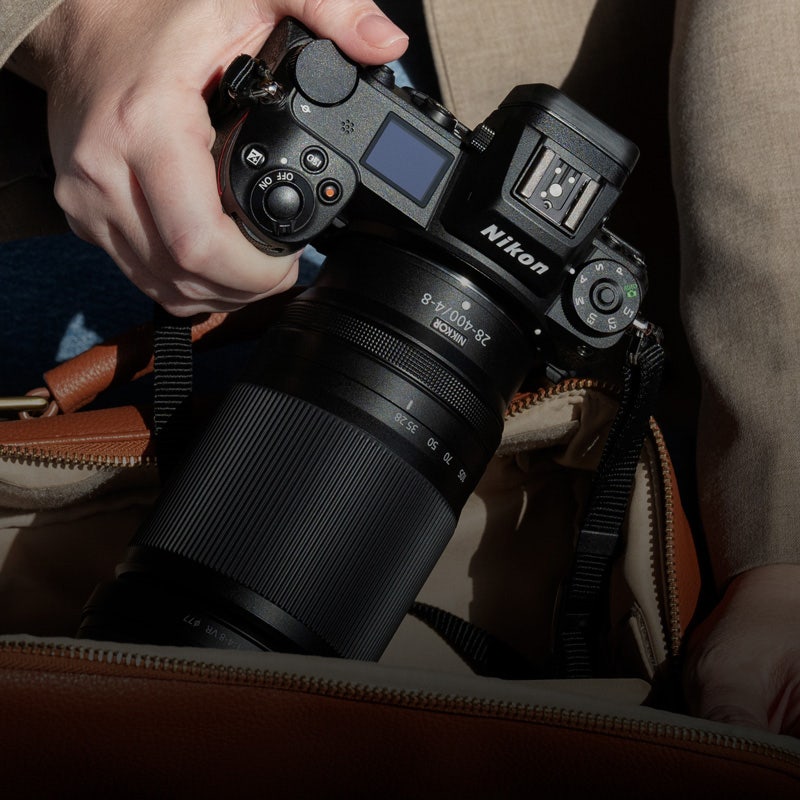

Learn & Explore - Z Series
Transform Your City Nightscape Photography


Beautiful city nightscapes are a sight to behold, but you might be surprised at the amount of technique required to capture their brilliance in fine detail. Such scenes, however, are great for fully demonstrating the impressive shooting capabilities of the Nikon Z series cameras. The cameras not only have built-in diffraction compensation, mid-range sharpening for finishing your images with even richer details, but can also be used with the Mount Adapter FTZ, which gives you greater freedom in choosing the lens to use. In this article, I will provide professional tips for city nightscape photography using the Nikon Z 7. (Report by Hiroyuki Yamashita)
Depiction 1: Depicting structures consisting of fine elements in detail
Nikon Z Series Tips: Increase Mid-range sharpening to +5
In order to depict the structure with a cool feel, I used the advanced settings in Picture Control to emphasize the outlines. Furthermore, I increased the Mid-range sharpening settings.


Nikon Z 7/ NIKKOR Z 24-70mm f/4 S (FL: 55mm)/ Manual exposure (f/8, 5 sec)/ ISO: 64/ WB: Preset manual/ Picture Control: Standard/ Release mode: Single frame/ Focus mode: MF
Mid-range sharpening is an absolute must for city nightscape photography
The interchange of an expressway, with its complex structure, showcases its functional beauty. The beautiful scene is packed with numerous elements, such as roads and structures including bridge piers, guard rails, and signs. To express these elements in fine detail, use the newly added Picture Control parameter "Mid-range sharpening". This lets you reproduce the various textures in the image, right down to the fine details, which allows you to create even more ideal images.
This setting will enable you to capture extremely detailed results, and by enlarging and viewing the detailed parts you can see the depictive capabilities of this camera. And when you look at the entire image again, you can tell that it managed to reproduce the cool yet beautiful view of the structure in every detail.
Nikon Z series settings for city nightscape photography #1:
Increase [Sharpening] together with Mid-range sharpening
By gradually increasing the Mid-range sharpening settings, you will be able to create even more ideal images of city nightscapes. To capture the structures, I also increased [Sharpening] and [Clarity] in the advanced settings of Quick sharp. In this way, I was able to express even finer lines and outlines.




Default setting for Picture Control [Standard]


[Standard], sharpening: +9


[Standard], Mid-range sharpening: +5


[Standard], Sharpening: +9, Mid-range sharpening: +5
Nikon Z series settings for city nightscape photography #2:
Use a Z mount lens that resolves sharply right to the edges
The new Z mount lens optimized for the Nikon Z series cameras can obtain a sharp and even depiction from the centre of the image right up to the edges. Hence, for this shoot, I selected the NIKKOR Z 24-70mm f/4 S. Even for an image taken at the telephoto end of 70mm, the lens lets in sufficient light right up to the edges, ensuring high resolving power.


Nikon Z series settings for city nightscape photography #3:
Two camera settings for shooting using a tripod to minimize camera shake
In order to obtain high image quality in nightscape photography using a tripod, remember to pay close attention to unwanted camera shake. To do so, you can connect a remote cord to the camera, turn vibration reduction off and silent photography on. It is important to release the shutter at a time when there is as little wind as possible.


Remote Cord MC-DC2
Remember to use genuine Nikon remote cords. The MC-DC 2 has a cable length of 1m, and lets you keep the camera shutter open by holding down the shutter button. This is useful for long exposure (bulb) photography. Of course, this is compatible with the Nikon Z series cameras.


Turn off vibration reduction
To prevent unwanted shake from occurring when using a tripod and release timer, select [Off] for [Vibration reduction] in the photo shooting menu.


Silent photography
Select [On] for [Silent photography] in the photo shooting menu. By eliminating shutter shock, you can reduce camera shake even further.
Depiction 2: Set the aperture as narrow as possible to lengthen light trails
Nikon Z Series Tips: Use Diffraction compensation to minimize diffraction
The brightness of the light trails varies depending on the contrast with the surroundings. Hence, if the surroundings are bright due to light sources like streetlights, select a faster shutter speed to bring out the brightness of the light trails.


Nikon Z 7/ AF-S NIKKOR 70-200mm f/2.8E FL ED VR (FL: 145mm)/ Manual exposure (f/13, 30sec)/ ISO: 160/ WB: 2,500K/ Picture Control: Standard/ Release mode: Single frame/ Focus mode: AF-S/ AF area mode: Auto-area AF/ Mount Adapter FTZ used
Diffraction surprisingly lowers the sharpness of images. In such cases, make use of the Diffraction compensation feature.
Scenes incorporating light trails are a staple depiction in nightscape photography. A tripod is a must-have item when creating light trails of car headlights, as these are long exposure shots. For exposure times exceeding 30 seconds or when the focal distance is long, pay more attention to camera shake.
In addition, in locations with strong light sources such as streetlights, you will need to be careful of ghosting and flaring. Adjust the angle of view using composition, zoom, or other means, to avoid such issues when creating images.
In cases where the lens you are using has a long focal length and you want to shoot in deep focus, you will be required to narrow your aperture for your shoot. I would recommend using the Diffraction compensation feature that is built into the Nikon Z series cameras. This can significantly reduce the loss of sharpness due to diffraction.


Nikon Z series settings for city nightscape photography #4:
Enable Diffraction compensation to restore sharpness
In the photo shooting menu, select [On] for [Diffraction compensation]


ON


OFF
The narrower the aperture, the more likely you are to experience diffraction, which causes images to lose sharpness. The impact of diffraction is evident even in this photo, which was taken using f/13. By using [Diffraction compensation], the improvement was apparent. Image quality is very important for city nightscape photography. Be sure to take advantage of the Diffraction compensation function.
Depiction 3: Reproducing straight vertical lines without perspective effects
Nikon Z Series Tips: Use the Mount Adapter FTZ and a PC-E lens


Nikon Z 7/ PC-E NIKKOR 24mm f/3.5D ED (FL: 24mm)/ Manual exposure (f/11, 15 sec)/ ISO: 200/ WB: 2,500K/ Picture Control: Standard/ Release mode: Single frame/ Focus mode: MF
While making full use of a 24mm angle-of-view, I used the shift mechanism to capture the impact of a complex cluster of buildings in the city with beautiful vertical lines.
Mount Adapter FTZ lets you use a wide range of NIKKOR lenses on the Nikon Z series
I used the shift mechanism of the PC-E lens to correct the tilt and shoot without perspective effects. PC-E lenses are F mount lens in the product lineup, and having a Mount Adapter FTZ allows you use any of these on the Nikon Z series. Photos taken using the Nikon Z 7 have a flawless finish. A cluster of tall buildings can be depicted with beautiful lines without perspective effects. There are over 80 types of NIKKOR lenses that can be used directly with the Mount Adapter FTZ while retaining image quality, making them a huge asset for the Nikon Z series.
However, when shooting in the vertical position as on this occasion, it was necessary to use the revolving mechanism to rotate the lens and enable the shift mechanism. At times like this, the lens may interfere with the mount head of your tripod, so you will need to devise a way such as using a smaller head.


Nikon Z series settings for city nightscape photography #5:
Raise the shift mechanism of the PC-E lens.
Mount a PC-E lens on the Nikon Z 7 using a Mount Adapter FTZ. Set the camera vertically on a tripod. Once it is level, use the revolving mechanism to rotate the lens, allowing you to use the shift setting in the vertical position. After that, by sliding the shift mechanism upward (rise), you will be able to create depictions without perspective effects.


Nikon Z series settings for city nightscape photography #6:
A PC-E lens may interfere with the tripod when the camera is set in the vertical position.
When using the shift mechanism of a PC-E lens for shooting in the vertical position, use the revolving mechanism, which allows you to rotate the lens 90 degrees to the left or right. When using this, the lens may interfere with the mounting head. You will need to devise a way of mounting the camera, such as using a smaller head.


Hiroyuki Yamashita
Born in 1970. Raised in Kumamoto Prefecture. After resigning from a construction company in Tokyo, he travelled the Australian continent on an off-road bike in 1996. Upon returning to Japan, he was deeply impressed by the works of the photographer Masaaki Aihara, who photographed Australia, and contacted him directly, becoming his assistant. After that experience, he started working as a freelance photographer from 2001 onwards.





